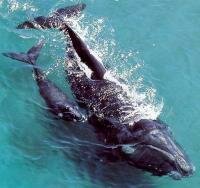| Southern Right Whales. |
 The SOUTHERN RIGHT WHALE has a circumpolar distribution and inhabits sub antarctic water between about 30° and 55° south. The whales migrate south during the summer months when supplies of krill are more prolific, and north during winter and spring to mate, calve and rear their young. They appear around the South African coastline from May to December. They can be seen interacting in the sheltered bays and coves close inshore and near river mouths. The SOUTHERN RIGHT WHALE has a circumpolar distribution and inhabits sub antarctic water between about 30° and 55° south. The whales migrate south during the summer months when supplies of krill are more prolific, and north during winter and spring to mate, calve and rear their young. They appear around the South African coastline from May to December. They can be seen interacting in the sheltered bays and coves close inshore and near river mouths.
Today, the NORTHERN RIGHT WHALE is virtually extinct. In the southern hemisphere populations show a slow increase since international protection in 1935. There are estimated to be about 3 000 - 4 000 SOUTHERN RIGHT WHALE at present, with South Africa receiving the major percentage visiting its coasts annually. Present populations of SOUTHERN RIGHT WHALES are a fraction of estimated initial stocks. The SOUTHERN RIGHT WHALE can be distinguished from other whales by its V-shaped 'blow' and the callosities which appear on and around its head. Although many people mistake these callosities for barnacles and although barnacles and other sea life live on these patches on the whale's head, the callosities are actual outgrowths of tough skin which form different patterns on each individual and which are a useful form of identification. |
| The "blow" |
 The "blow" is a cloud of vapour produced largely by condensation when warm breath comes into contact with cooler air and drops of water from around the blowhole being forced up with the rush of air as the whale breathes. It also contains oily mucus from the respiratory tract of the whale. The "blow" is a cloud of vapour produced largely by condensation when warm breath comes into contact with cooler air and drops of water from around the blowhole being forced up with the rush of air as the whale breathes. It also contains oily mucus from the respiratory tract of the whale.
As yet, knowledge about whales and the role they play in the marine ecosystems is fragmentary. However initial benign research indicates that whales are of greater benefit alive than dead to man. For this reason, if for no other, they need our protection. |
| COURTSHIP AND MATING |
 Courtship behaviour in whales can be very spectacular. Displays of breaching and tail slapping are common, and the whales touch each other frequently. Courtship of a female whale may take many days. Mating appears to occur in deeper water, and the females may mate with more than one male. |
| PREGNANCY AND BIRTH |
|
After a successful mating the female SOUTHERN RIGHT WHALE has a gestation period of about 12 months.
The 5 - 6 metre calf is born tail-first, and is gently nudged to the surface (often assisted by a 'midwife' whale) to take its first breath. The calf will then find the mother's nipple and she will squirt the milk into the calf's mouth. The milk is very rich, and calves add 50kg per day to their initial weight of 1000kg. At 10 to 12 months the calf is weaned off its mother and will begin to eat small krill. |
| HOW DO THEY BREATHE ? |
| As we know, SOUTHERN RIGHT WHALES are mammals and so they need to breathe air, unlike fish. The SOUTHERN RIGHT WHALE has two nostrils or blowholes, fairly widely separated. This is the reason for the distinctive 'V' shaped blow. When on the surface whales breathe once every minute or so, for 5 to 10 minutes, and then dive again. Up to 60 minutes below water has been recorded, but this is unusual, and 10 to 20 minutes is more common. |
| WHALE DESCRIPTION AND FACTS |
 Black Colour with occasional white markings along back and underside; the body is stocky and fat, smoothly rotund without a trace of dorsal fin or any ridge along the back. Black Colour with occasional white markings along back and underside; the body is stocky and fat, smoothly rotund without a trace of dorsal fin or any ridge along the back.
The length varies between 14 and 18 metres, with a mass of 40 to 80 tons (average of 54). The SOUTHERN RIGHT WHALE has a cruising speed of around 5 - 8 km/h or 2 - 3 knots and it's lifespan is estimated to be 90 - 100 years. Whales are large brained and sensitive creatures. Strong bonds exist between females and their calves. In normal circumstances they are non-aggressive and gentle towards man. |
| Whale Hotline |
 People can now phone from anywhere in the world to find out where the whales are along our coast. The Whale Hotline's office is in daily contact with all the information offices on the whale route from Plettenberg Bay to Lambert's Bay. People can now phone from anywhere in the world to find out where the whales are along our coast. The Whale Hotline's office is in daily contact with all the information offices on the whale route from Plettenberg Bay to Lambert's Bay.
The Hotline can be reach by phoning their toll-free number - Tel 0800 228222. |
|
Copyright © 2000 - Dorea ISP, All rights reserved!
www.capeoverberg.co.za/Htmlfile/whales.html |